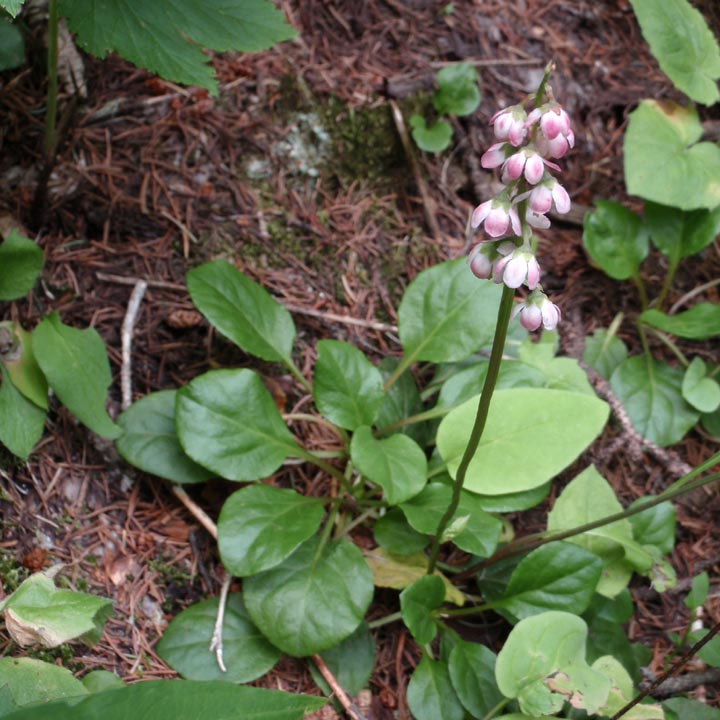|
Family: Ericaceae |
Herbs, chlorophyllous, autotrophic (achlorophyllous and heterotrophic in forms of P. chlorantha and P. picta). Stems erect, glabrous. Leaves essentially basal or, sometimes, highly reduced or absent (P. chlorantha, P. picta), alternate; petiole present; blade maculate or not, elliptic, ovate-elliptic, oblong-elliptic, oblanceolate, oblong-obovate, ovate, obovate, spatulate, subreniform, reniform, or round, subcoriaceous to coriaceous, margins entire, denticulate, crenulate, crenate, or crenate-serrulate, plane or revolute, surfaces glabrous. Inflorescences racemes, usually erect in flower and fruit, (symmetric); peduncular bracts present or absent; inflorescence bracts free from pedicels. Pedicels pendent in fruit; bracteoles absent. Flowers radially symmetric (bilaterally symmetric in P. minor), spreading or nodding; sepals 5, connate proximally, often obscurely so, calyx lobes lanceolate, ovate, triangular, deltate, oblong, or obovate; petals 5, distinct, white, greenish white, yellowish white, pink, or purplish red, without basal tubercles, corolla crateriform to broadly campanulate; intrastaminal nectary disc absent; stamens 10, exserted; filaments broad proximally, gradually narrowed medially, slender distally, glabrous; anthers oblong, without awns, with or without tubules, dehiscent by 2 round to elliptic or obovate pores; pistil 5-carpellate; ovary imperfectly 5-locular; placentation intruded-parietal; style (exserted or included), bent downward or straight (P. minor), expanded distally; stigma 5-lobed, without subtending ring of hairs. Fruits capsular, pendulous, dehiscence loculicidal, cobwebby tissue exposed by splitting valves at dehiscence. Seeds ca. 1000, fusiform, winged. x = 23. The apparent absence of strong genetic discontinuities within many species complexes, as well as morphologic and cytologic uniformity, have challenged attempts to delimit species in Pyrola. Chromosome counts for all species are diploid (2n = 46) except for the boreal European species P. media, which is a tetraploid (2n = 92), and some triploid counts (2n = 69) for P. grandiflora. Natural hybrids have been reported widely. Some species complexes have been examined in detail; a modern, comprehensive monograph of the genus is needed. Of particular interest in the flora area are relationships among members of sect. Pyrola, which includes, among other species, North American P. americana, amphi-Pacific P. asarifolia, arctic and circumpolar P. grandiflora, and Eurasian P. rotundifolia Linnaeus. J. V. Freudenstein (1999b) found limited cladistic structure in Pyrola. Morphologic and molecular data support a clade comprising P. chlorantha and P. picta (including P. aphylla). Molecular data suggest that this clade is sister to one comprising P. elliptica and P. minor. Pyrola americana, P. asarifolia, P. chlorantha, P. elliptica, and P. picta have a variety of drug, food, and ceremonial uses among a dozen tribes of Native Americans (D. E. Moerman 1998).
PLANT: Perennial rhizomatous, scapose herbs. LEAVES: alternate, in basal clusters of one to several year's growth. SCAPES with bud scales at base and one to several bracts along scape; inflorescences glabrous symmetric bracteate racemes. FLOWERS: actinomorphic, drooping, and bell-like (P. minor), or zygomorphic, bowl-like; petals without basal tubercles on upper surfaces, the upper two generally forming a hood over the upturned stamens; filaments tapered from base, glabrous; anther sacs mainly with tubes, each opening by a pore; pollen grains in tetrads; disk absent; style short, straight, included, or elongate, downward curved, exserted; stigma peltate, the style apex forming a reflexed collar, the collar enlarged, with 5 radiate lobes (P. minor), or small, with 5 erect, finger-like lobes. FRUITS: 5-locular drooping capsules with a depressed center and fibers connecting opened valves. x = 23. NOTES: About 15 spp. worldwide, mainly in north temperate regions; 6 spp. in North America. (Diminutive of Pyrus, pear, from vague similarity in leaves). Haber, E. 1972. Rhodora 74:396 397; Haber, E. 1984. Canad. J. Bot. 62:1054 1061; Haber, E. 1987. Syst. Bot. 12:324 335. REFERENCES: Haber, Erich. 1992. Pyrolaceae. Ariz.-Nev. Acad. Sci. 26(1)2. Pet 5; filaments elongate, slender; anthers subapically attached, opening by terminal pores, the pollen sacs often prolonged above into short tubes; style ±elongate; capsule opening from the base upward; rhizomatous herbs, the few broad, petiolate lvs nearly basal, persistent throughout the winter (rarely the lvs suppressed); fls in an erect, terminal, long-peduncled raceme. 40/N. Temp. Gleason, Henry A. & Cronquist, Arthur J. 1991. Manual of vascular plants of northeastern United States and adjacent Canada. lxxv + 910 pp. ©The New York Botanical Garden. All rights reserved. Used by permission. |


